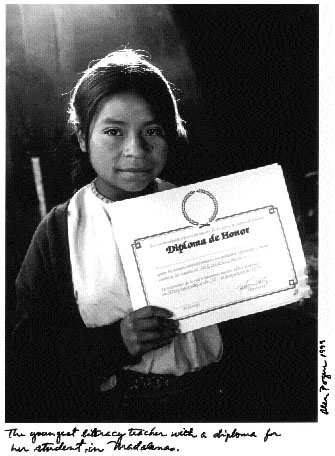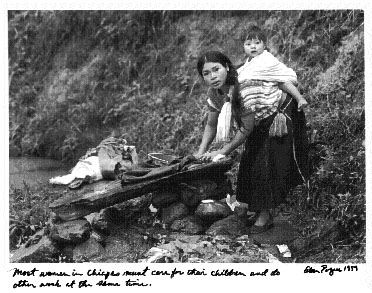Afterword
Where are the Zapatistas?
— DATELINE: MEXICO CITY
It has now been over 100 days since the General Command of the Zapatista Army of National Liberation (EZLN) has been heard from–and they have not been just any 100 days either. Since the last communiqué signed by the Zapatistas’ charismatic spokesperson Subcomandante Marcos (dated June 19), which warned of imminent military invasion, the long-ruling Institutional Revolutionary Party (PRI) has lost the presidency to the right-wing National Action Party (PAN). In Chiapas, meanwhile, an opposition coalition candidate, Pablo Salazar, overthrew the PRI at the polls in August to become that conflictive state’s next governor. Yet neither of these millennial milestones in modern Mexican political history have elicited a response from the EZLN.
When President-elect Vicente Fox proposed to reposition the military in Chiapas and send to Congress the long-stalled Indian Rights accords negotiated between the rebels and the outgoing government of Ernesto Zedillo in 1996, the Zapatistas’ only comment was “no comment.” Patriotic holidays–and September is stippled with them–are always an occasion for EZLN communiqués. Yet September has come and gone without a whisper from Marcos. Even the Battle of Prague during the recent World Bank-IMF conclave in that Czech city failed to move the Subcomandante, a full-time “globalphobe”, to forward a message of solidarity. The EZLN’s stony silence begs the question: are the Zapatistas history?

These days, few visitors travel down the rutted canyon road to the EZLN’s most public outpost, La Realidad, a tiny hamlet tucked deep in the Lacandon jungle. Gone are the foreign correspondents who would wait weeks there for a chance to chat with Subcomandante Marcos. Celebrated writers like Eduardo Galeano and Regis Debray and Manuel Vazquez Montalban no longer hang up their hammocks in the ejido house. Danielle Mitterand and Oliver Stone do not pay courtesy calls. Even the Mexican daily La Jornada, once dubbed “The Daily Zapatista”, has moved on to livelier fronts. Mail left in La Realidad for the EZLN with Max, the town’s liaison to the rebels, is never picked up, and anyway, Marcos is not writing back. Max claims that he has not seen the comandantes, who are purportedly encamped in the nearby sierra, for months. In fact, the only excitement in La Realidad now is the military convoy which still rolls through town twice a day, automatic weapons trained on the villagers. But if the comandantes are resolved to keep their silences, the Zapatista autonomous communities in the jungle and the highlands continue to churn out a steady stream of “denuncias” (complaints) against local PRI authorities, the military, and even one-time allies in what the EZLN calls its “war against oblivion.” Perhaps the most disturbing recent communication from the Zapatista bases denounced the Independent ARIC (Rural Collective Interest Association), a long-time friend of the EZLN, for refusing to yield land to the autonomous municipality named for Francisco Gomez, an ARIC founder himself. Such squabbling between allies hints at serious decomposition in the rebels’ base communities. The denuncias from the grass roots, while laced with anger and revolutionary resonance, are very local in scope and lack the acute analysis and world vision of the communiqués with which Subcomandante Marcos galvanized the nation for years.
The current muteness is not the EZLN’s first protracted silence. For ten years before their surprise January 1, 1994 uprising, silence served the comandantes to keep their movement well-hidden from the Mexican government. After breaking off negotiations with the Zedillo government in January 1997, because of the president’s veto of the Indian Rights accords that his own representatives had signed, the General Command once again went silent, severing communications for the next 18 months, the last five of which Marcos remained totally incommunicado. The prolonged quiescence was finally broken by a flood of communiqués, culminating in the fifth (and thus far, the final) Declaration of the Lacandon jungle, in July 1998.
During this vow of silence, only the massacre of 46 Tzotzil Indian EZLN supporters in the village of Acteal (by PRI-affiliated paramilitaries) provoked Marcos to take up his florid pen. “Silence is an Indian weapon,” he wrote then to justify the Zapatista mumness, insisting that native peoples have always clammed up when confronted by governments. “We had said all we needed to say,” the Subcomandante explained to La Jornada crack chronicler Hermann Bellinghausen. “We decided to let Zedillo do the talking until everyone got tired of listening to him.” Silence helped the Zapatistas to hear better and decide what to do next, the rebel spokesperson has said. But he also conceded that the EZLN had lost contact with national and international support bases “when we went into our submarine.”

In fact, the EZLN was never able to recover the momentum lost in their long absence from the public spotlight, and during the ensuing year-long (1999-2000) presidential election campaign, the insurgents virtually disappeared from the media. The current spate of silence has pushed the EZLN even further from public notice, and should negotiations on Indian Rights and other substantive issues be revived in the coming Fox administration, the Zapatistas will be hard put to muster the sort of support that was instrumental in achieving the accords in the first place. For years, Subcomandante Marcos peppered those in power with punctual commentary on the injustices of national life under the seven decade rule of a one-party state. His epistles stimulated public debate and let a blast of fresh air into the sealed political system controlled by the PRI. The Sub’s messages rang with truth in a landscape of extreme hypocrisy; without Marcos’s shrewd sniping, national political life is much grayer.
Today, despite Vicente Fox’s salespitch of a glowing future, post-electoral depression and disillusionment are more the mood of Mexico than ever. As the parties go through the motions of what seems a scripted wrestling match, attacking the president-elect with sour grape-style political venom, Marcos’s acid-dipped, jokey communiqués, his surreal tales of Durito the talking beetle and Old Antonio’s Mayan creation myths, are sorely missed. Yet the silence from the mountain remains immutable. With Marcos’s prolonged absence from the scene (he has not been physically seen for over a year), the stage upon which so much high drama once played itself out seems strangely deserted. Gone is San Cristobal’s legendary liberationist bishop Samuel Ruiz (retired at the behest of the Vatican) and his outspoken successor Raul Vera (exiled by the Church to the northern desert.) Lame-duck president Ernesto Zedillo, whose entire “sexenio” (six year term) encapsulates the Zapatista rebellion, will dissolve into political obscurity in a matter of months along with his bulldog governor Roberto Albores, who caused so much pain during his abbreviated reign in the statehouse. Gone too will be Defense Secretary Enrique Cervantes, whose troops have been a perpetual flashpoint for conflict in Chiapas. In the end, only the Indians will remain.
Conjecture about the EZLN’s maddening muteness is generalized. The same rumors that flew during the Great Silence of 1997-98 have resurfaced: Marcos is dead, the victim of internal strife in rebel ranks; Marcos is dead or dying of malaria or cancer; Marcos has eloped to Europe with his last-reported lover, Marianna, AKA “La Mar.” One school affirms that the EZLN’s conditions for resuming negotiations–a military pull-back and the legislation of the Indian Rights accords–must first be fulfilled before the Zapatistas break their silence. Some observers, such as ex-EZLN advisor Luis Hernandez Navarro, ask why the rebels should waste their breath on Foxian promises when nothing at all has changed for the Indians of the jungle and highlands of Chiapas? Another school contends that the EZLN’s Clandestine Indigenous Revolutionary Committee (CCRI) is gravely divided about what to do next without the PRI in power. Some even suggest that the Fox and Salazar victories at the polls make the EZLN’s war against the “mal gobierno” (bad government) obsolete. One popular perception is that electoral politics have stolen the thunder from the armed option identified with the EZLN, the Popular Revolutionary Army (EPR) and other guerrilla formations.
In other words, they say, the EZLN is history. The Zapatista Army of National Liberation is indeed history. From their January 1994 uprising in the first hours of the North American Free Trade Agreement through the watershed presidential election of 2000, the Zapatista rebellion has spanned and often spawned monumental changes in Mexico: the death of the PRI, the recognition of indigenous peoples as full-fledged citizens, the growth of civil society into a force to be reckoned with by those in power, and the building of a world-wide movement against global neo-liberalism, to name just the most obvious impacts the armed movement has gestated. The Zapatistas’ current silence does not signal the end of this uniquely transforming rebellion. In Chiapas, rebellion is often subterranean, running underground until it gathers sufficient force to break into the sunlight and shatter the silence.
These photos and others by Alan Pogue will be on display in November at Harvard’s Rockefeller Center for Latin American Studies. Bishop Samuel Ruiz, a longtime advocate of Indians in Chiapas, will speak at the Center on November 10.
John Ross will be touring the U.S. West Coast this November with his latest handiwork, The War Against Oblivion: Zapatista Chronicles 1994-2000, the season by season, six-and-a-half year saga of the rebellion in Chiapas.


